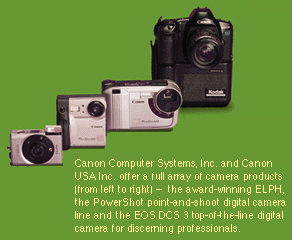
 ince introducing its first camera more than 50 years ago, Canon has become the world's leading camera company. Canon was a leader in the 35mm revolution, and today offers cameras with high-performance lenses, Autofocus TTL (through-the-lens), Eye-Controlled Autofocus, Optical Image Stabilizing Technologies, Advanced Photo System and many other advanced technologies.
ince introducing its first camera more than 50 years ago, Canon has become the world's leading camera company. Canon was a leader in the 35mm revolution, and today offers cameras with high-performance lenses, Autofocus TTL (through-the-lens), Eye-Controlled Autofocus, Optical Image Stabilizing Technologies, Advanced Photo System and many other advanced technologies. 
In digital photography, CCSI's first point-and-shoot digital camera, the PowerShot 600, has won numerous awards for its outstanding performance at less than $1,000. The PowerShot 600 earned a PC Magazine's Editor's Choice award, a Stellar Award from Windows Sources, was named Best of What's New by Popular Science and won Mobile Computing and Communications' MOBY Award.
Canon's line-up of EOS cameras and EF lenses, now in their tenth year of production, have become the best-selling 35mm SLR system in the world. Canon EOS system offers a number of exclusive technologies like the AIM System for multi-point autofocusing and metering, Ultrasonic Motors for fast, quiet lens focusing, and Image Stabilizer (IS) technology, which dramatically reduces the chance of a blurred photo due to camera shake.
In digital photography, the Canon EOS DCS 3 offers the quality professionals demand. It offers superior color reproduction, with 36-bit digital capture, and a 1.3 megapixel CCD sensor that gives it extremely high resolution of 1268 x 1012 pixels. The EOS DCS 3 also offers a large buffer memory for continuous shooting, removable PCMCIA storage of images, and a built-in microphone for recording sound clips. Completely compatible with Canon's whole line of Canon's EF lenses, the EOS DCS 3 is the choice of discerning professionals.
EOS is also known for its advanced autofocus system. EOS IX, for example, has a built-in 16-bit computer that makes instant autofocus decisions to ensure the best photograph. One autofocus mode uses an Artificial Intelligence algorithm to increase focusing accuracy with moving subjects. In addition, Canon is one of five major photographic manufacturers (Fuji, Kodak, Minolta and Nikon) which founded the new Advanced Photo System (APS), and in 1996 introduced three highly stylized and multi-functional cameras, including the EOS IX, designed to take full advantage of the system's advance technology. APS is a new standard in consumer photography based on a unique film format and innovative film, camera and photofinishing technologies that offer consumers simple film loading, flexibility on print sizes and improved photo quality.
Canon's first APS camera, the ELPH, is designed to be the world's smallest 2x zoom camera to take advantage of APS's compact film cartridge and Canon's unique space-saving technologies. The ELPH features Canon's exclusive hybrid autofocus system with passive and active autofocus. It makes taking pictures easier than ever, with carefree drop-in loading, built-in flash and fully automatic operation.
As the recognized worldwide leader in optical imaging technology, Canon has received a Technical Emmy in Overall Excellence in Broadcast Lenses from the National Academy of Television Arts and Sciences (1996) and its precision-molded aspherical glass lenses are used on more than 60 percent of the world's professional television cameras as well as Canon brand cameras, camcorders and office machines. In addition, Canon's L2 camcorder is responsible for all transmissions made to earth by all NASA shuttle flights.
From the affordable quality of the PowerShot 350 and 600, to the EOS DCS series for the professional, Canon offers a complete line of digital photography solutions.